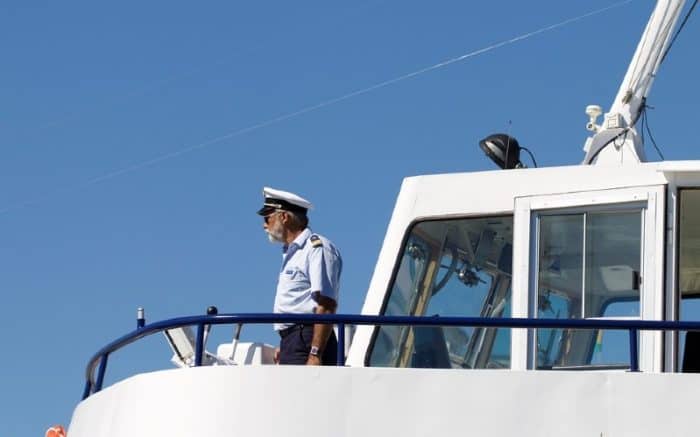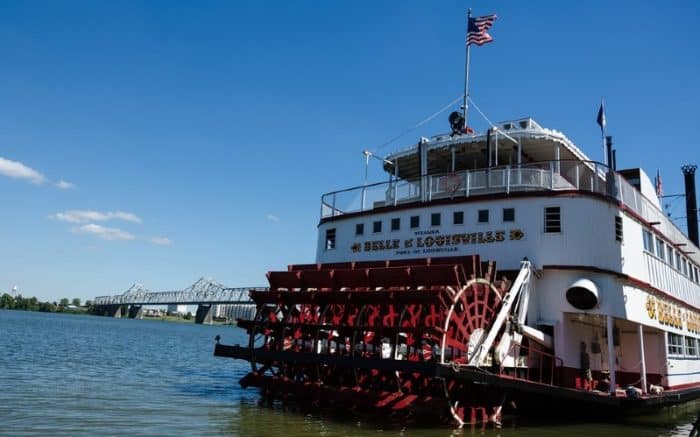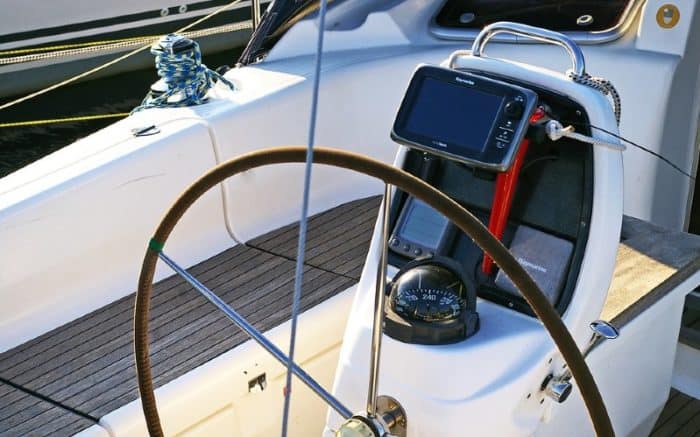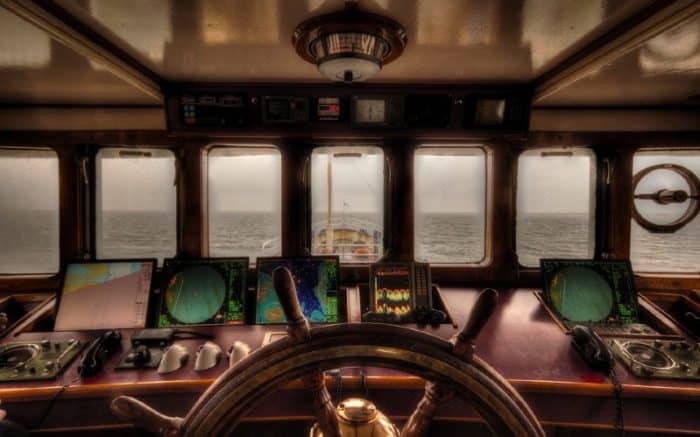What is a Ship’s Bridge?
Even if you’re not a sailor you know the word “bridge.” It’s been used for years to describe the command center of a ship and can be colloquially used to apply to any ship. Even in sci-fi it’s used to describe the command deck of a starship. But how is it different from the ship’s wheelhouse? Or the quarterdeck? Or the helm? And why is it even called a bridge? Turns out there’s more to a ship’s bridge than most people realize.
Terms Across the Entire Ship
A good place to start is defining some simple terms.
Bridge: There is actually more than one way to understand the bridge. First, it’s the entire structure above the weather deck. It covers the width of the vessel and it is where the command center itself is located. Many parts of the ship can be controlled from here including often unmanned machinery spaces. The command center is often just called the bridge, even though it covers more space.
Flying Bridge: This was above the pilot house and was not enclosed. Also called a flybridge, this was the highest navigation point on a ship. From here, a sailor would have an unobstructed view in every direction. They could relay information about directions or obstructions to the helmsman below.
Navigation Bridge: Later vessels were built with more than one bridge. The navigation bridge was the place from where the ship was actually controlled. The helm was controlled from this bridge so if a captain needed to change speed or direction, it would be done here.
Admiral’s Bridge: This would be located on large naval vessels, notably the flagships. Apart from the navigation bridge, a separate admiral’s bridge was a place for an admiral to command an entire squadron or fleet, but not the individual ship he was on. That command was still for the captain, on the navigation bridge.
Conn: If you haven’t heard this in real life you may have in movies. The conn, con, conne, and several other spellings all mean the same thing. And it’s not a physical place but a state. The person running the ship has the conn. If they give it to someone else, the new person has the conn. Whoever has the conn gives the orders.
Conning Tower: Old warships and submarines also had conning towers. These armored chambers allowed for control of the vessel in combat situations as they were considered most secure. In essence, they were a combat bridge. You could still consider the room within the conning tower a bridge and call it that as well. For instance, on submarines the bridge is located in the conning tower but the entire tower isn’t necessarily considered the bridge.
Engine Room: The engine room is where the machinery that actually makes the boat go is located. Commands from the bridge are relayed to the engine room. This allows sailors in the engine room to increase or decrease speed as needed. On older vessels like those paddle steamers, this would have included things like adding more coal to fires to increase power.
Bridge Wing: These may exist on larger ships. They extend over the sides of the ship next to the flying bridge or pilot house. Like the name says, they make the ship look like it has small wings on either side. These are often used to aid in maneuvering. A sailor can get a clearer look to the side of the boat from a bridge wing. That way if the boat is trying to dock, or deal with smaller vessels nearby, the area is easily viewed from the bridge wing.
Cockpit: This term is most often associated with aircraft. However, on smaller sailing vessels the control area is also called a cockpit. This is usually located in an open well sort of area. Traditionally this was where the coxswain would operate the boat.
Wheelhouse: This is another term for bridge but it is usually reserved for referring to a smaller vessel like a tugboat. Traditionally it was just a small structure in which the ship’s wheel would be found. Even on a smaller vessel like a tugboat, there can still be a flybridge located on top of it. Usually this is surrounded by a simple railing. The binnacle can be located on the flybridge along with things like spotlights or other tools to aid in navigation.
Pilothouse: Similar to a wheelhouse, the pilothouse is another term used to describe the bridge of a smaller vessel. Pilothouses on modern yachts are often recessed a step or two. The inside of the pilothouse is comfortable with navigation and steering set up for ease of use. The enclosed space and seating ensure that whoever is on watch day or not will be relatively warm, dry and comfortable.
Quarterdeck: On older vessels, the quarter deck was the raised deck from which the captain commanded. It was behind the main mast. Because it was elevated, it gave the captain a better view of the ship and the surrounding area. These days it typically just refers to the area at the stern of a ship.
Helm: A captain may tell a helmsman they “have the helm” and put them in command if they leave the bridge. The helm, strictly speaking, is the actual wheel or steering mechanism for the boat. It’s located on the bridge and figuratively represents commanding the ship.
As you can see, there are a lot of terms tossed around when discussing boats. Many of them are used interchangeably today. However, most of these are distinct terms that are technically not meant to be swapped out. That said, most of us are not going to be piloting modern warships or world war II sailing ships. Knowing exactly all the right terms isn’t going to ruin your boating experience or make it any better. But it’s good to at least be familiar with the terms and how they were originally used.
Where is the Global Positioning System?
You would think that if a ship is controlled from the bridge, that’s where the GPS would be. But that’s not necessarily the case. This all depends on the type of ship and how it’s designed. The control of a ship is generally managed from the bridge, navigation isn’t always located in the same place.
A navigation station is employed on some vessels. This is where a ship’s navigator can plot courses and refer to charts, GPS, and other tools. A magnetic compass, compass platform and more tools may be used here.
Literally a Bridge to Paddle Houses
So why did people start calling a bridge a bridge? We know what the word bridge means already and the bridge of a ship doesn’t make sense at first glance. Even if it’s not physically a bridge, the word usually refers to something that connects two parts. A bridge in your teeth, a bridge in music, a bridge over water. These all are ways to refer to something that connects things.
As weird as it sounds to us today, that is exactly where the word “bridge” when referring to boats comes from. And that, in turn, is mostly thanks to old paddle steamers.
In the 19th century, paddle steamers began to become the dominant type of vessel on the water. They’re powered by a steam engine that turns a giant paddle wheel which propels the boat forward. They’re still used in some places and a few paddle steamers operate as hotels and casinos if you’re inclined to visit one.
Paddle steamers were able to replace using oars and sails. They ensured a boat could remain under constant power and progress down rivers and along the coast no matter the weather. The cost of this was using a giant paddle wheel. The larger the vessel, the larger the wheel. Some were well over 10 feet in diameter.
The rotating wheels needed to be monitored by engineers in case anything went wrong so that meant they needed views from above. But the captain needed an unobstructed view as well. There were paddle houses on either side of the wheel and a bridge was built that connected them over top. In essence this was just a large, raised walkway. This became the command center for the vessel and the spot from which a captain could observe everything. It was literally a bridge that spanned from one side of the ship to the other.
How Does the Bridge Work?
As we’ve seen, a bridge must be elevated. A clear view of the sea ahead needs to be a main point of any bridge. Even with electronic navigation equipment, nothing beats a good line of sight. The bridge needs to offer an unobstructed view of the world around it. There are actual guidelines that stipulate the field of view that is required on a ship’s bridge. There must be a minimum field of 255⁰ present for the officer on watch. In addition this must include at least 112.5⁰ visibility on both the port and starboard sides.
The side of the boat must be clearly visible with 180⁰ on the side and 45⁰ to the opposite side. When it comes to the helmsman steering the vessel, 60⁰ on both sides is the minimum clear visibility.
From the bridge, a captain can direct the bridge crew in a number of tasks. Whether it’s a military vessel, a commercial freighter, a cruise ship or a large fishing vessel, the captain runs the ship from here.
All communication needs to begin or end at the bridge. Even if control is given over elsewhere, such as the case of using a conning tower, it needs to be communicated clearly from the bridge. That’s because there are potentially a lot of people on any vessel. Everyone needs to know who’s in control at all times. Otherwise things can get confusing and potentially dangerous.
On a smaller vessel, this is not a concern like it would be on those massive freighters or military vessels. Nonetheless, everyone must know who is in command at all times. And having centralized control is key to organization. Big vessel or small, you know where the captain is located and know to listen to them.
Depending on the kind of vessel you’ll find a captain, a chief mate, second mate, third mate, able seamen and ordinary seamen on a bridge. Ordinary seaman is the starting rank for any deckhand and this person may have no experience on a ship whatsoever.
A ship should have at least two hands on the bridge at all times. That could be the captain and an able seaman, or a mate and an able seaman, and so on. The office of the watch steers the ship and an able seaman can do a walkthrough of the whole vessel. This will happen during a single watch shift, which would last for four hours.
Navigating the vessel safely is the chief goal of any shift for the bridge crew. That does not mean it’s the only job, however. Depending on the vessel, there are secondary concerns that will be addressed. Military vessels may have to be monitoring for enemy activity. Fishing vessels will likely be looking for fish or pots that have been placed earlier. Science vessels could be conducting research. All of this will be organized from the bridge, however.
How is the Bridge Laid Out?
Obviously the layout of the bridge will depend on the ship. A ship of war is going to look a little different than your uncle’s yacht. But in general, a ship’s bridge should follow the same basic design and layout if it’s to be functional.
To that end, the fore of the bridge should be laid out for clear observation. That means unobstructed views out of the windows on all sides. A captain should be able to stand in the center of the bridge and see what’s ahead and off to the sides easily.
The rest of the space on the bridge is where the equipment is found. This can be simple or complex depending on the vessel. You’ll find the equipment necessary for steering, communication and navigation. Control of thrusters can be managed here on larger vessels, and smaller props on smaller vessels. This goes along with control of the rudders and engines as well. On large ships these control panels can cover a wide amount of space. On smaller ones it’s typically just the steering wheel and a small panel of controls.
Although primary control of the engine is controlled from the engine room, the bridge relays the necessary commands.
On smaller, private vessels the real benefit to a pilothouse style bridge is the actual protection and comfort. Your gear, especially expensive electronics, are kept away from sun, wind and rain. You’re also able to keep out of harsh weather yourself should a storm roll in unexpectedly. And it may even offer you the chance to observe wildlife or other interesting features in the world around you without being seen, something like a hunter’s blind.
The Bottom Line
There’s a lot going on when you get to the bridge of a ship. There’s a lot of history there, even behind the use of the word itself which many of us probably never think about. But on a large commercial vessel or a small private one it’s good to understand the history. Knowing why the bridge is laid out as it is and its intended use is important for understanding how any vessel is intended to be run.
Categories: Boats















